So where did the traffic go?
Burrard flowed smoothly:
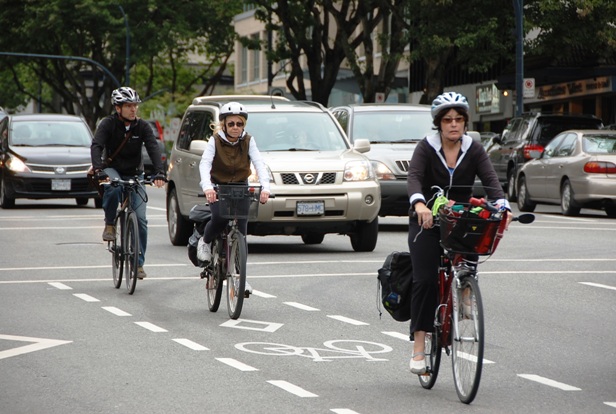
Granville had capacity to spare:
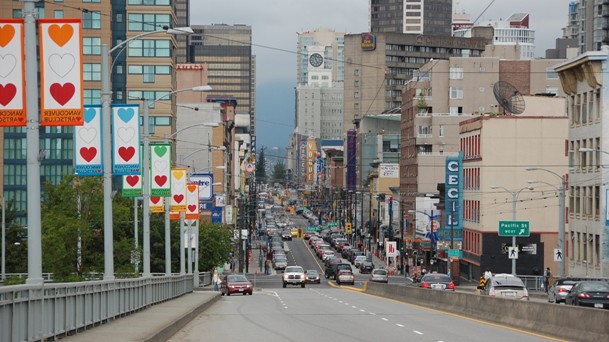
There was some back-up on Pacific, but only for two or three blocks:
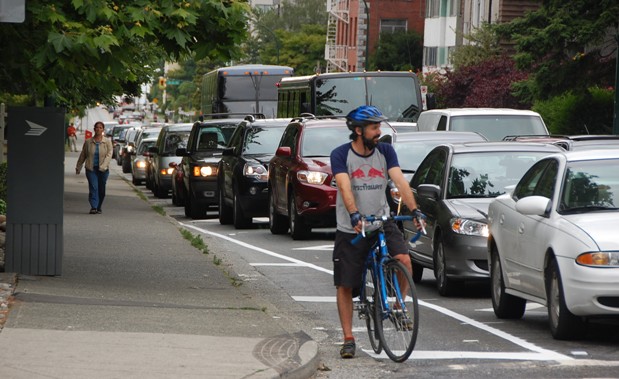
Same on the east lane of the bridge for exit traffic heading onto Pacific – a not uncommon situation. But overall, there was so little congestion that even City Caucus had to admit the experiment was a success.
Given that even some of the more neutral transportation engineers thought that back-ups would be severe, it makes one wonder …
If, as the phrase goes, you build it and they will come, does this mean that if you remove it, they will go away? (The Germans would understand. It’s the corollary of Braess’s Paradox.)
More likely, it was the consequence of sufficient preparation, both by the engineers (who did a remarkable job in paving and striping Pacific, as well as preparing the bridge over the weekend) and communications media in preparing the public.
It was also a testament to social networking, given the turnout of cyclists and their positive messaging that effectively offset the complaints that accompany this kind of cultural change.
And a cultural change it is. There’s no way the bridge will ever go back to its previous condition. Vancouver itself has changed; we’re a different, greener city than we were in 1996.
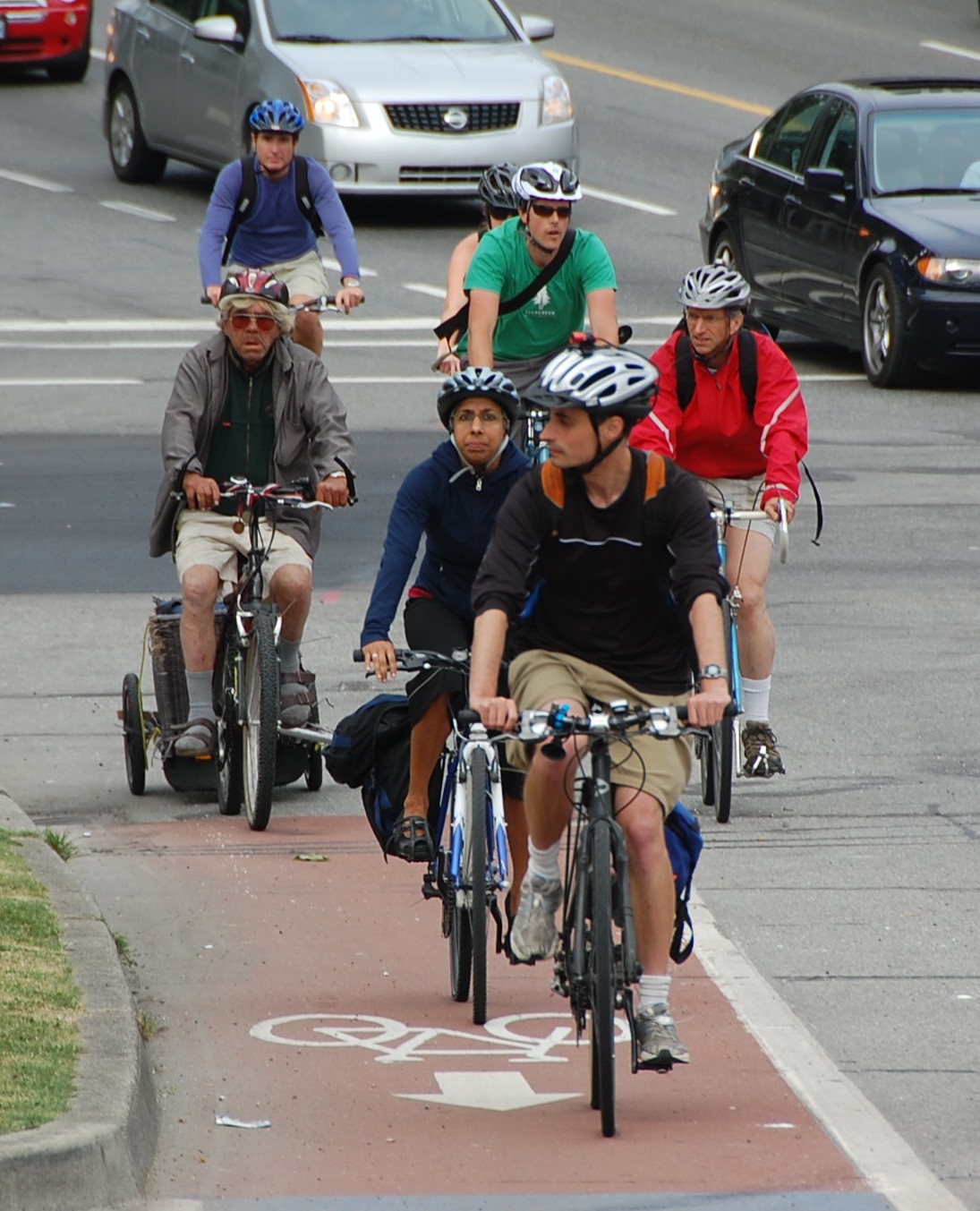
But there will have to be some changes. When the bridge’s sidewalks and railings are rebuilt, no doubt the lanes will be reconfigured. And problems with the free rights (see below) will have to be addressed, probably sooner. There’s too much happening, particularly at the northwest corner, in too small a space as drivers try to navigate the merge while cyclists are speeding down the Burrard Street grade.
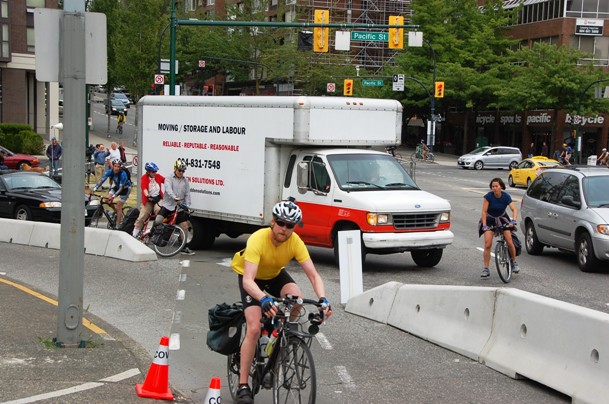
Pacific and Hornby have their own problems. Too little space on the street for west-bound cyclists:
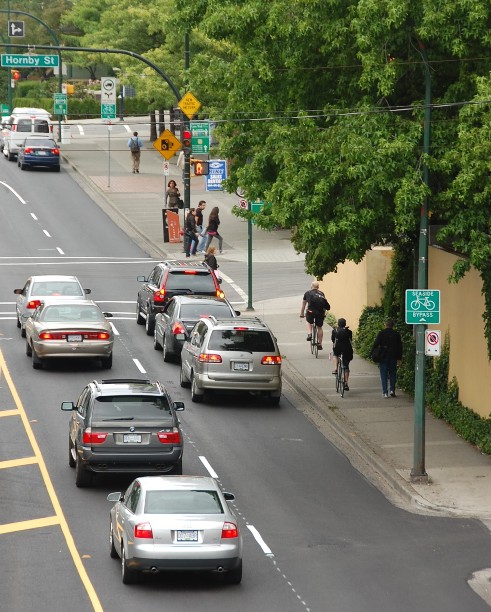
A problematic left-turn on to Hornby:
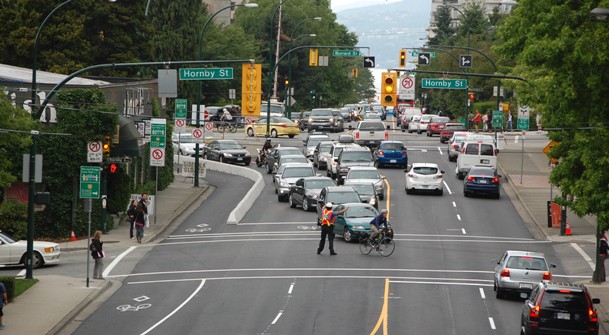
The prohibition of a right-turn onto Hornby by motorists, negatively affecting the businesses, might be abandoned without any real downside for cyclists by using a New York signal (pioneered on their 8th-Avenue bike lane) – depending on the lessons of the next few weeks.
So stay tuned for lots of speculation on just what those lessons are. I’ll be out of town for the rest of the week, so I’ll leave that up to you.
But here’s one more. Maybe, just maybe, the reason the traffic flowed so well on Burrard Street and the bridge,defying (and disappointing) the critics of doom, is because enough motorists decided to cycle instead. Proving that there’s no real need for a culture war.














Hah, I thought I recognized you standing by the southwest corner of Burrard & Pacific as I rode southbound this afternoon, looks like I was right.
Great pictures and comments Gordon. Thank you for your courage to be the first.
Good job with the pics and commentary, Gordon.
Thanks!
Thanks Gordon for some great photography and synopsis of the results.
It looks like the bike lane will be a success this time around- what a relief that our city is making some good, sustainable transportation choices!
These pictures speak volumes. It’s so great to see the smiling kids taking to the road on their bikes. I’m optimistic that, as you said, there’s no way we’re going back!
Nice pics.
The normalization of the Pacific to Burrard right turn would help the blockage situation a bit, but with the right turns having to wait (instead of having their own lane) you automatically see a lot more inching out by the right turning cars to get into the few narrow openings available – plus, as currently configured, the right turning cars need to cross an extra lane (the bus lane) to get to that opening in traffic (so either you inch out farther (but block cyclists) or dangerously gun it and screech tires to shoot into that opening in traffic). If the right turn is normallized, the bus lane south of Pacific could become a de facto merge lane for the right turning cars.
Ultimately, I think that drivers will shortcut from Thurlow to Burrrard using side streets to the north (instead of using Pacific) and distribute the traffic volume. The exception would be drivers coming from the Lions Gate Bridge who use Denman, Beach Ave. then Burrard.
I do see a no left turn sign at Hornby (from westbound Pacific)- looks like its in effect during rush hours.
…”But overall, there was so little congestion that even City Caucus had to admit the experiment was a success”….
“even City Caucus had to admit”…must have been painful,considering the raison de etere of CC = “Vision bad”
http://www2.news.gov.bc.ca/news_releases_2009-2013/2009PREM0017-000141.htm
Now that the PST and GST are “harmonized”, bicycles will pay the new 12% HST rate. Their old exemption under the PST, brought in at the urgings of the late Emery Barnes, has been removed.
If cyclists obeyed the rules of the road, I might be supportive of this project. Cyclists have blown stop signs, stop lights, they go the wrong way down one way streets… One cyclist decided to pass a stopped schoolbus down on Union the other day and just about hit a girl trying to cross.
While the motorists in Vancouver are hilariously stupid by North American standards (Don’t get me started comparing the drivers here to those in Europe, it just wouldn’t be fair). Cyclists in this city are just as unbearably bad.
On a sidenote: All that traffic on Pacific going left on to Hornby northbound might be reduced somewhat IF PEOPLE TURNED ON THE RED! Hornby is a one way street. Turning left onto a one-way street is legal in B.C. regardless if the street you’re coming off of is one way or two way. It’s not some hidden traffic rule. Just perform the turn as you would a right turn: Stop, yield to pedestrians and cross-traffic, pull out, complete turn when it’s safe.
There’s so many problems in this city that I would almost say it’s less to do with cyclists and motorist alike and more to do with road designers and engineers. It’s just at that level of fail. The Burrard Street project is a joke. There are other ways to help cyclists cross the bridge without driving another wedge into motorist-cyclist relations.
Speaking of which, do you guys mind if you stop lane splitting and passing me on the right in traffic? It’s terribly unsafe and I’m being forced to bring my car right up to the curb to stop you from doing that to prevent my vehicle from being damaged and to prevent you from going under the wheels of my car.
‘Next to a roadway’ -cycling is far more dangerous than ‘on road way’ -cycling due to conflicts it creates at every point of intersection. This traffic engineering fact has been known for decades and evidence supporting it has been growing and growing. ‘Next to a roadway’ -cycling is widely believed to be safer by ignorant public and certain parties have taken a populist approach and given the public what it wants instead of what it needs.
This is unethical, unsustainable and counterproductive. All nations should instead follow the lead of the new British national cycling program that empowers cyclists to operate as equals on roadways by educating them to occupy as much space they need to safely operate and to avoid the typical accident situations. In addition to the education effort there should be social campaigning that propagates that integrated cycling is good, safe and normal and that cyclists are intended vehicular users on every public roadway.
I can guess that Kalle Mustonen is promoting “vehicular” cycling, and is not short of ranting on people disagreeing with him unfortunately by giving UK as an example, he is missing some crucial points:
First:
UK with a population of 60M has close to 2000 fatalities on road, Canada with twice less has 50% more – fact: UK roads are three time safer than Canadian road.
Understandably, it is easier to sell “vehicular traffic” in Uk than in Canada.
Second: By European standard UK is a laggard when come to cycling:
it has one of the lowest bike modal split, and in despite to have the highest level of helmet use in Europe, it is order of magnitude more dangerous to cycling in UK than in most of other European country having otherwise as good as road safety record as UK, such Netherlands.
So Sorry to say that massive Evidence of continental Europe show that t people are right to follow the Netherland path and not the UK one when come to cycling!
——————
regarding the fact that ‘Next to a roadway’ has been known more dangerous for decades.
first, a decade ago is an eternity in European road safety, in 2010, there is twice less fatalities on the road of Germany, France, Spain… than it was in 2000…
I am not sure people here in Canada comprehend that yet, but decades ago 17,000 were dying on French road, nowadays this number has been reduced by 4000. EU with 500M people has now not more people dying on the road, than US with 40% less people !
Nowadays Canada road safety record is similar to the one found in Poland ! Canada could fare very poorly by European standard.
Decades ago it was not like it and decades ago, European cycle track was like in Richmond today, but European has learn a lot, and what was true only 10 years ago is not anymore…
Secondly, Kalle lack the big picture:
Bike lane, like a medication with secondary effect, could have locally some disadvantage but they are ofsetted by huge positive effect.
New York or Montreal bike safety record, could totally blast the ill informed certitude of Kalle:
There, with cycle track development on full speed, cyclist safety has been improved by 50% or so…
(even the replacement of bike lane by a segregated cycle track on 9th avenue has lead to 60% reduction of bike accident on the avenue).
That is result you can’t argue with, and that is the reason Kalle didn’t provide any backing to his rant…
For my number, you can google it, but I agree that cycle track like bike lane, need to be properly designed: we are not there yet in Vancouver area, and regarding Richmond very far away: see my last post http://voony.wordpress.com/2010/10/23/bike-errand-in-lulu-island/